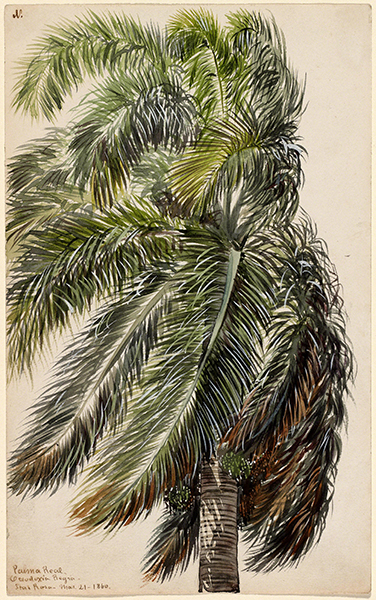World Watercolor Month: Charles Brownell
I’m closing out my World Watercolor Month series with the work of Charles de Wolf Brownell. Many of Brownell's most standout landscapes and nature studies are his watercolors. His watercolor works display his highly intuitive use of watercolor in the depiction of light, something that was explored in depth in the 1880s and 90s by Winslow Homer (1836–1910) and John Singer Sargent (1856–1925). At this time, watercolor was still primarily a study medium for works later executed in oil, but Palma Real is a beautiful stand-alone work.
 |
| Charles de Wolf Brownell (1822–1909, U.S.), Palma Real (Royal Palm), 1860. Watercolor and gouache on wove paper, 8 ½" x 5 ¼" (21.5 x 13.4 cm). National Gallery of Art, Washington, DC. (NGA-P1136) |
Brownell's most distinctive works are the paintings he produced in Cuba while recovering from a respiratory illness (probably tuberculosis) starting in 1853. He also visited other Caribbean islands and South America, creating many charcoal sketches, oil sketches, and watercolors that he later translated into oil on canvas.
The artist established form through layers of overlapping washes, much like Chinese monochromatic landscape painters did. Unlike Homer’s and Sargent's watercolors, Brownell's palette is a traditional academic one that incorporates blacks and greys to achieve nuances of shades. He used both the white of the paper and white gouache to achieve highlights, something Homer and Sargent explored in great depth in their watercolor works.
Brownell was born in Providence, Rhode Island, but his family moved to Harford, Connecticut, when he was 2 years old. His parents forced him to study law, and he was admitted to the Connecticut bar in 1843. He privately harbored a desire to pursue a career in the arts, and his opportunity came after his debilitating illness in 1853.
He initially studied watercolor in Hartford under Julius Theodore Busch (1821–1858), a landscape painter. More importantly, he studied with Joseph C. Ropes (1812–1885), a painter from Salem, Massachusetts, who was renowned for his landscapes and topographical studies of the growing city of Hartford. Brownell had a studio in Hartford until 1860, when he moved to New York. In New York, he immediately became acquainted with artists from the Hudson River School and exhibited at the National Academy of Design and Brooklyn Art Association as early as 1861.
Correlations to Davis programs: Explorations in Art 2E Grade 2: 1.1; Explorations in Art 2E Grade 4: 1.8; Experience Painting: Chapter 4


Comments